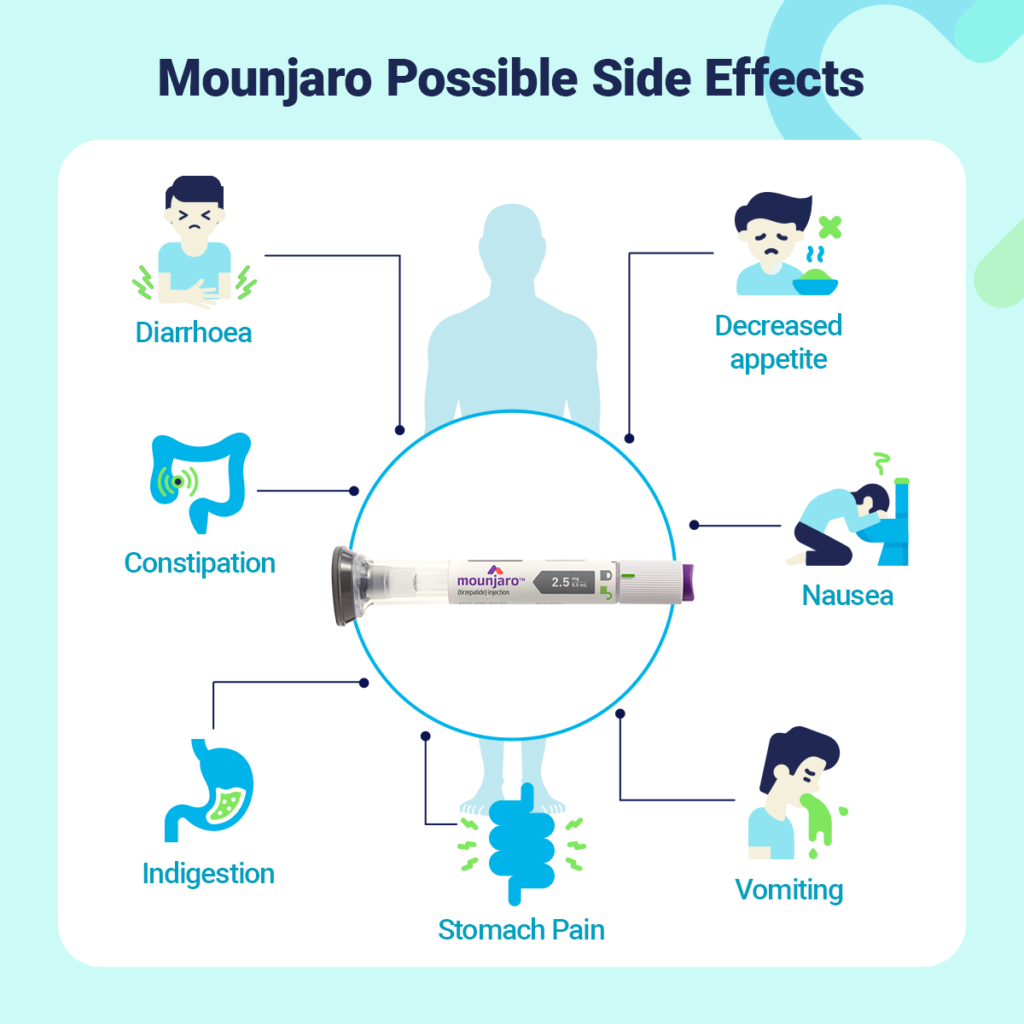Tirzepatide causes nausea by slowing gastric emptying and stimulating GLP-1 receptors. This affects the digestive process and satiety signals.
Tirzepatide is a medication used to manage type 2 diabetes and promote weight loss. It works by mimicking hormones that regulate blood sugar and appetite. While effective, it often causes gastrointestinal side effects, including nausea. The medication slows down the rate at which food leaves the stomach, leading to feelings of fullness and discomfort.
This can trigger nausea as the body adjusts to the slower digestive process. Understanding these side effects is crucial for patients and healthcare providers to manage them effectively. Proper dosing and gradual titration can help minimize these adverse effects, improving patient compliance and treatment outcomes.
The Mechanism Of Tirzepatide
Tirzepatide is a novel medication primarily used to manage type 2 diabetes. This drug is known for its effectiveness but often causes nausea. Understanding the mechanism of Tirzepatide can help explain why nausea occurs.
Dual Incretin Agonist Action
Tirzepatide works as a dual incretin agonist. It activates two important receptors: GLP-1 and GIP. These receptors play crucial roles in blood sugar regulation.
GLP-1 receptor activation slows down food emptying from the stomach. This can cause feelings of fullness and nausea. GIP receptor activation helps with insulin secretion. Balancing these two actions is complex and can lead to nausea.
Impact On Gastric Motility
One major side effect of Tirzepatide is its impact on gastric motility. The drug slows down the movement of food through the digestive system. This delayed emptying can make you feel nauseous.
Here are some key points:
- Slows down stomach emptying.
- Increases feeling of fullness.
- Can lead to bloating and nausea.
Doctors monitor patients closely to manage these side effects. Adjusting the dose can sometimes reduce nausea.
| Mechanism | Effect |
|---|---|
| Dual Incretin Agonist Action | Slows stomach emptying, increases insulin secretion |
| Impact on Gastric Motility | Delays food movement through the digestive system |

Credit: my-bmi.co.uk
Common Side Effects Of Glp-1 Receptor Agonists
GLP-1 Receptor Agonists, like Tirzepatide, are used for managing diabetes. They work by mimicking the GLP-1 hormone, which helps regulate blood sugar levels. Despite their benefits, they may cause side effects. Understanding these side effects can help manage them better.
Gastrointestinal Symptoms
One common side effect of GLP-1 Receptor Agonists is nausea. This happens because these medications slow down gastric emptying. The delay in the stomach emptying can make you feel full longer, leading to nausea.
Other gastrointestinal symptoms include:
- Vomiting
- Diarrhea
- Constipation
- Abdominal pain
These symptoms are usually mild and tend to decrease over time. Eating smaller meals and avoiding fatty foods can help reduce these symptoms.
Comparing Side Profile With Other Medications
GLP-1 Receptor Agonists are often compared with other diabetes medications. Here’s a simple comparison:
| Medication | Common Side Effects |
|---|---|
| GLP-1 Receptor Agonists |
|
| Metformin |
|
| Sulfonylureas |
|
Each medication has its own side profile. GLP-1 Receptor Agonists tend to have more gastrointestinal effects. But they are less likely to cause low blood sugar compared to Sulfonylureas.
Understanding The Role Of Gip In Nausea
Tirzepatide is a medication used to treat type 2 diabetes. It can cause nausea in some patients. This nausea is linked to GIP, or glucose-dependent insulinotropic polypeptide. Let’s explore how GIP contributes to nausea.
Gip Receptor Activation
GIP works by activating specific receptors in the body. These receptors are called GIP receptors. They are found in the digestive system and brain.
When Tirzepatide is taken, it stimulates these GIP receptors. This can lead to nausea. GIP receptor activation changes how the stomach empties. It slows down the movement of food through the stomach.
This slow movement can make people feel queasy. It can also lead to bloating and discomfort. This is one way Tirzepatide causes nausea.
Nausea Triggering Pathways
Nausea is a complex process. It involves many different pathways in the body. One key pathway is the brain-gut axis. This is a communication system between the brain and digestive tract.
When GIP receptors are activated, signals are sent to the brain. These signals can trigger the feeling of nausea. The brain responds by releasing neurotransmitters. These chemicals make you feel sick to your stomach.
Another pathway involves the vagus nerve. This nerve connects the brain to the stomach. When stimulated, it can cause nausea. GIP activation affects this nerve, leading to nausea.
| Pathway | Effect |
|---|---|
| Brain-Gut Axis | Triggers nausea through brain signals |
| Vagus Nerve | Causes nausea through nerve stimulation |
Understanding these pathways helps us see why Tirzepatide causes nausea. It shows the role of GIP in this process.

Credit: www.goodrx.com
Patient Experiences With Tirzepatide
Many patients have reported their experiences with Tirzepatide. Some common side effects include nausea. Let’s explore these experiences in detail.
First-hand Reports Of Nausea
Many patients taking Tirzepatide share their stories. Nausea is a frequent complaint. Some describe it as mild, while others find it severe. Here are some first-hand accounts:
- John, 45: “I felt queasy every morning for the first week.”
- Maria, 52: “The nausea was intense, but manageable with small meals.”
- Ahmed, 38: “I had nausea, but it got better after a few days.”
These experiences show that nausea is a common issue. Yet, its intensity varies among patients.
Adaptation Over Time
Many patients find that nausea decreases over time. Their bodies adapt to the medication. Here are some insights:
- Initial Weeks: Nausea is most intense during the first few weeks.
- Gradual Improvement: Symptoms often lessen as the body adjusts.
- Long-term Use: Many patients report minimal nausea after months of use.
Doctors often suggest starting with a low dose. This can help reduce initial nausea. Drinking plenty of water and eating small meals can also help.
| Week | Patient Experience |
|---|---|
| 1 | Strong nausea, frequent discomfort |
| 2-3 | Nausea starts to decrease, manageable with diet changes |
| 4+ | Minimal nausea, body adapts |
Understanding these experiences can help new patients prepare. Knowing what to expect can make the journey easier.
Mitigating Nausea When Taking Tirzepatide
Tirzepatide is a promising medication for diabetes and weight management. But it can cause nausea. Here, we explore ways to reduce nausea from Tirzepatide.
Dosage Adjustments
Doctors often start with a low dose to minimize nausea. Gradually increasing the dose helps the body adapt. This method can significantly reduce nausea symptoms. Always follow your doctor’s dosage instructions.
Lifestyle And Dietary Changes
Simple changes in lifestyle and diet can also help manage nausea.
- Eat smaller, more frequent meals throughout the day.
- Avoid greasy, spicy, or heavy foods.
- Stay hydrated by drinking plenty of water.
- Include bland foods like toast, rice, and bananas in your diet.
These adjustments can make a big difference in how you feel.
Dietary Table
| Foods to Eat | Foods to Avoid |
|---|---|
| Toast | Fried Foods |
| Rice | Spicy Foods |
| Bananas | Heavy Meals |
Always consult your healthcare provider before making any changes.

Credit: my-bmi.co.uk
Frequently Asked Questions
How Do You Stop Nausea From Mounjaro?
Eat small, frequent meals and stay hydrated. Avoid spicy or greasy foods. Ginger tea or candies can help. Rest in a quiet, dark room. Consult your doctor if symptoms persist.
How To Avoid Nausea In Tirzepatide?
Start with a low dose and gradually increase it. Eat smaller, frequent meals. Avoid fatty or spicy foods. Drink plenty of water. Consult your doctor for personalized advice.
How To Avoid Side Effects Of Tirzepatide?
To avoid side effects of tirzepatide, follow your doctor’s dosage instructions. Maintain a balanced diet and hydrate well. Monitor your body’s reactions and report any adverse effects to your healthcare provider promptly. Avoid alcohol and consult your doctor before combining tirzepatide with other medications.
How Do You Control Semaglutide Nausea?
Eat smaller, more frequent meals. Stay hydrated by drinking plenty of water. Avoid greasy, spicy, and high-fat foods. Take semaglutide with food. Consult your doctor for additional medication if needed.
What Is Tirzepatide?
Tirzepatide is a medication used for managing type 2 diabetes by enhancing insulin production and reducing blood sugar levels.
Why Does Tirzepatide Cause Nausea?
Tirzepatide can slow stomach emptying, leading to feelings of fullness and nausea as a side effect.
How Common Is Nausea With Tirzepatide?
Nausea is a common side effect, experienced by many patients during the initial weeks of treatment.
Can Nausea From Tirzepatide Be Managed?
Yes, nausea can be managed by eating smaller, more frequent meals and avoiding fatty foods.
Does Tirzepatide Dosage Affect Nausea?
Higher doses may increase the likelihood and severity of nausea. Consult your doctor for dosage adjustments.
How Long Does Nausea Last With Tirzepatide?
Nausea often subsides after a few weeks as the body adjusts to the medication.
Conclusion
Understanding why Tirzepatide causes nausea helps manage side effects effectively. This knowledge empowers patients and healthcare providers. With proper guidance, side effects can be minimized. Always consult a healthcare professional before starting or adjusting medication. Stay informed for better health outcomes.


